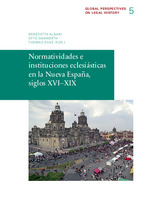Normatividades e instituciones eclesiásticas en la Nueva España, siglos XVI–XIX
| dc.contributor.editor | Albani, Benedetta | |
| dc.contributor.editor | Danwerth, Otto | |
| dc.contributor.editor | Duve, Thomas | |
| dc.date.accessioned | 2019-04-12 11:13:30 | |
| dc.date.accessioned | 2020-04-01T10:32:30Z | |
| dc.date.available | 2020-04-01T10:32:30Z | |
| dc.date.issued | 2018 | |
| dc.identifier | 1004831 | |
| dc.identifier | OCN: 1050438358 | en_US |
| dc.identifier.uri | http://library.oapen.org/handle/20.500.12657/25263 | |
| dc.description.abstract | "Ecclesiastical institutions and actors were essential for the formation of normative orders in early modern Ibero-America. However, both legal historiography, due to its strong legalistic, state-centred imprint, and general historiography on colonial times, more inclined towards secular law, have only rarely discussed the contribution of ecclesiastical normativity to the formation of that normative texture which, in the historiographical tradition, has been called ‘derecho indiano’. In light of this situation, the Max Planck Institute for European Legal History has organised a series of seminars in different Latin American cities in order to offer an interdisciplinary forum dedicated to the research of ‘ecclesiastical normativities and institutions in Ibero-America’ between the 16th and 19th centuries. The present volume is the first in a series of publications that document the results of this cycle of seminars celebrated in Mexico City, Lima, Bogotá and São Paulo. The book, focusing on New Spain, is divided into five thematic parts. The first section presents investigations on canon law and moral theology that deal with characteristic aspects of multinormativity and the teaching of those disciplines in early modern times. The second section examines diocesan governance and ecclesiastical power in Mexico City and Puebla via statutes of the cathedral chapter, members of the ‘curia arzobispal’ and pertinent legal opinions. In the third section, the contributors reflect on the normativity and administration of sacraments, drawing on conciliar norms, treatises, pragmatic literature but as well on registers of baptisms and confessions. The fourth section deals with ethnic groups in courts of justice, both civil and ecclesiastic ones: indigenous people accused of ‘hechicería’ in a tribunal of Tlaxcala and Afro-Mexicans who started litigation in the archiepiscopal court of Mexico. The articles of the fifth section cover the topics of beatification, devotion and cultural expressions (music, images) from a normative perspective and extend the period of investigation to the 19th century. The articles on ecclesiastical institutions and normativities in New Spain collected in this volume propose new research fields for legal history and the history of the Church, which at the same time are relevant for social and cultural history. The editors’ purpose has been to present approaches that explore the relationship between different types of normativities, their local adaptations, the ties with global debates, the forms of solving conflicts, as well as the role of jurists, theologians and other actors. The topics discussed by the authors represented in this volume – who cultivate the disciplines of history, legal history, church history, ethnohistory, art history and the history of music – contribute to a better understanding of the normative religious universe in Spanish America." | |
| dc.language | Spanish; Castilian | |
| dc.relation.ispartofseries | Global Perspectives on Legal History | |
| dc.subject.classification | thema EDItEUR::N History and Archaeology::NH History::NHD European history | en_US |
| dc.subject.classification | thema EDItEUR::N History and Archaeology::NH History::NHK History of the Americas | en_US |
| dc.subject.classification | thema EDItEUR::N History and Archaeology | en_US |
| dc.subject.classification | thema EDItEUR::3 Time period qualifiers::3M c 1500 onwards to present day | en_US |
| dc.subject.classification | thema EDItEUR::L Law::LA Jurisprudence and general issues::LAZ Legal history | en_US |
| dc.subject.other | church history | |
| dc.subject.other | Legal History | |
| dc.subject.other | moral theology | |
| dc.subject.other | canon law | |
| dc.subject.other | multinormativity | |
| dc.title | Normatividades e instituciones eclesiásticas en la Nueva España, siglos XVI–XIX | |
| dc.type | book | |
| oapen.identifier.doi | 10.12946/gplh5 | |
| oapen.relation.isPublishedBy | aa1e4fa2-ec92-41bb-bd06-19453b9e6e41 | |
| oapen.relation.isbn | 9783944773148 | |
| oapen.series.number | 5 | |
| oapen.pages | 316 | |
| oapen.place.publication | Frankfurt am Main | |
| oapen.identifier.ocn | 1050438358 |

